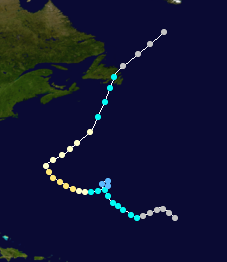| Category 2 hurricane (SSHWS/NWS) | |
 Hurricane Karen shortly after its peak intensity near Bermuda on October 2 | |
| Formed | September 28, 2019 |
|---|---|
| Dissipated | October 8, 2019 |
| (Remnant low after October 5) | |
| Highest winds | 1-minute sustained: 100 mph (155 km/h) |
| Lowest pressure | 982 mbar (hPa); 29 inHg |
| Fatalities | 15 total |
| Damage | $273 million (2019 USD) |
| Areas affected | Bermuda, Newfoundland |
| Part of the 2019 Atlantic hurricane season | |
Hurricane Karen was a strong Category 2 hurricane that struck the islands of Bermuda and Newfoundland. The eleventh tropical storm and sixth hurricane of the 2019 Atlantic hurricane season, Karen formed a low pressure area in the open ocean on September 28. Although it was designated as a tropical storm immediately after it formed, it didn’t became a hurricane until October 1st. It later intensified into a Category 2 and on October 2, it reached its peak intensity with 100 mph (155 km/h) winds and a pressure of 982 mbar. A few hours later, it made a direct hit on Bermuda, weakening to a Category 1 12 hours later and then to a tropical storm on October 4. It then struck Newfoundland the next day, transitioning into a extratropical cyclone shortly after.
Karen caused $273 million (USD) and 15 deaths, 9 were killed in Bermuda and 6 were killed in Newfoundland. Bermuda suffered during this storm, buildings and boats damaged, electricity out for a couple days. Karen was the first tropical cyclone to strike Newfoundland while remaining tropical since Maria of 2011. Newfoundland had heavy gusts and rain that caused moderate flooding.
Meteorological history

Map plotting the storm's track and intensity, according to the Saffir–Simpson scale
Tropical storm (39–54 mph, 63–87 km/h)
Category 1 (74–95 mph, 119–153 km/h)
Category 2 (96–110 mph, 154–177 km/h)
Category 3 (111–129 mph, 178–208 km/h)
Category 4 (130–156 mph, 209–251 km/h)
Category 5 (≥157 mph, ≥252 km/h)
A low pressure area formed on September 25, heading northwest. It was recognized by the NHC that following day, giving it a low chance of forming. It then after being recognized, abruptly organized over slightly warm waters. On September 27 12:00 UTC, the NHC quickly designated it as Potential Cyclone Twelve, after it was given an 80% chance of forming. It eventually became a tropical storm the next day, the NHC naming it Karen.
It slowly turned northwest as it remained a tropical storm for a couple of days. On September 30 00:00 UTC, it weakened to a tropical depression, now beginning to loop around. The next day, it completed its small loop and that same time, intensified back into a tropical storm, now curving slightly toward the island of Bermuda. On October 1st 00:00 UTC, it strengthened into a Category 1 hurricane and then 12 hours later, it further intensified into a Category 2. On October 2 00:00 UTC, it reached its peak intensity with sustained winds of 100 mph (155 km/h) and a minimum pressure of 982 mbar. 6 hours later, it made a direct hit on Bermuda while holding on to this intensity.
After its direct hit, it gradually weakened due to cooler waters, becoming a Category 1 12 hours later. Then, it abruptly turned northeast. Despite those cooler waters, it didn’t transition into an extratropical cyclone yet. On October 4 06:00 UTC, it weakened to a tropical storm, heading now north-northeast toward the big island of Newfoundland. On October 5 00:00 UTC, it eventually made landfall there, quickly transitioning into an extratropical cyclone a few hours later.
